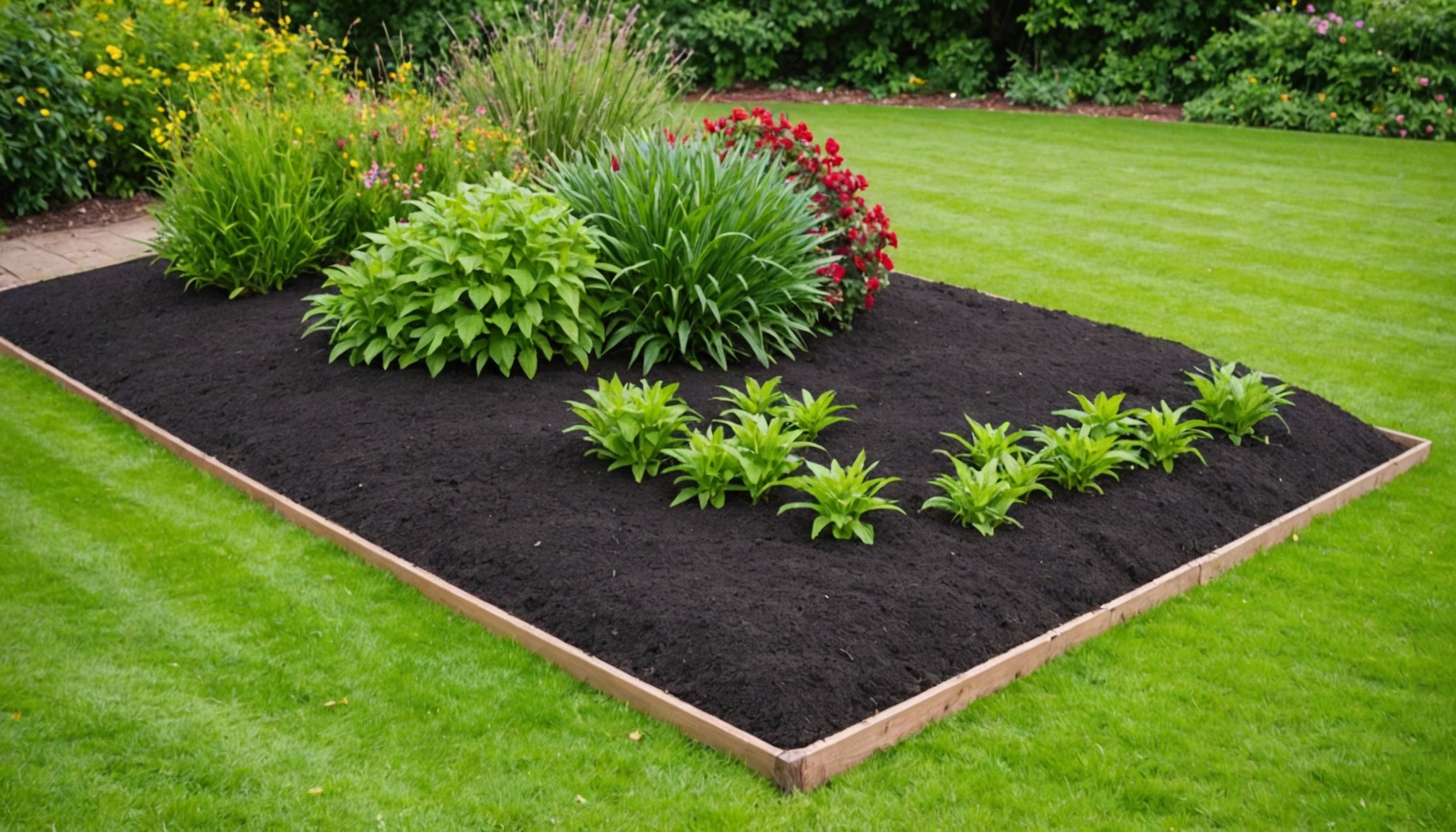Overview of Mulching Techniques
Mulching is a crucial gardening practice designed to cover the soil surface around plants with various materials, promoting healthier plant growth. Among its primary purposes is weed control, a vital factor in flower bed maintenance. By forming a protective layer, mulch prevents sunlight from reaching weed seeds, thus inhibiting their germination.
There are several mulching techniques suited to different environments and gardening needs. Organic options like wood chips, straw, and compost provide dual benefits of enriching the soil while controlling weed growth. In contrast, inorganic mulching materials like gravel or landscape fabric offer long-lasting solutions, ideal for gardeners needing minimal maintenance.
Also read : Essential Tips for Effectively Winterizing Your Northeast UK Pond
Each technique has its specific advantages, tailored by the garden’s requirements. For instance, organic mulch materials decompose over time, enhancing soil fertility while serving as excellent weed barriers. On the other hand, inorganic solutions are lauded for their durability, often used in gardens where frequent maintenance isn’t feasible.
Understanding these techniques’ functionality significantly impacts weed management by offering a viable, sustainable method of maintaining flower beds. A well-chosen mulching strategy supports vigorous plant growth, thereby increasing your garden’s aesthetic and functional value, while ensuring optimal weed suppression.
In the same genre : Mastering the Art of Propagating Rare UK Native Plants: Effective Techniques for Success
Types of Mulching Materials
Choosing the right mulching materials significantly impacts a garden’s health and appearance. Mulch types are broadly categorized into organic and inorganic options, each with distinct characteristics suited to different garden needs.
Organic Mulch Options
Organic mulch includes materials such as wood chips and bark, which add a natural aesthetic to gardens while enhancing soil fertility as they decompose. Straw and grass clippings are cost-effective and easily accessible, providing excellent coverage and soil enrichment. Leaf mold and compost further enrich the soil, promoting biodiversity and improving plant health. As organic materials breakdown, they add valuable nutrients to the soil, fostering a thriving garden ecosystem.
Inorganic Mulch Options
In contrast, inorganic mulch options like landscape fabric and plastic sheeting offer durability and require minimal maintenance. These materials are particularly effective for long-term weed suppression. Gravel and stones provide excellent drainage and a neat appearance, often used in areas with heavy rainfall. Rubber mulch, made from recycled tyres, is durable and resilient against decay, offering a sustainable solution for suppressing weeds without frequent replacement.
Benefits of Using Mulch for Weed Control
Mulching significantly benefits weed suppression, acting as a natural barrier that hinders weed germination by blocking sunlight and thereby reducing the chance of weeds competing with plants for nutrients. Optimal mulch application more effectively limits weed growth than traditional weeding.
Furthermore, mulch enhances soil moisture retention. By covering the soil, mulch reduces water evaporation, which can significantly decrease the frequency of irrigation, especially crucial during dry periods. This capability keeps the plant roots cool and efficiently utilises water resources, promoting robust growth.
Another remarkable advantage is the enhancement of soil fertility and health. As organic mulch decomposes, it gradually releases nutrients into the soil, fostering a stable environment for beneficial microorganisms. This process not only supplies essential nutrients for plants but also enriches the soil’s texture and aeration, thus improving plant health and vigour.
Inorganic mulches, though not decomposing, provide prolonged physical weed control and can also stabilize soil temperatures, creating a microclimate conducive to healthy plants. Together, these benefits of mulch create a sustainable gardening practice that offers significant advantages in maintaining a healthy, vibrant garden environment while keeping weeds in check.
Climate Considerations for Mulching in the UK
Understanding how the UK’s diverse climate affects mulching is essential for effective garden care. Mulching techniques should be tailored to suit regional climate variations and specific mulching seasons.
Regional Climate Variations
In coastal areas, frequent rain can wash away light organic mulches like straw or grass clippings. Therefore, using heavier materials such as bark or gravel is advisable. Inland areas might experience more temperature fluctuations, demanding rubber mulch or landscape fabric that retains soil warmth during cooler spells, especially vital for flower beds in exposed locations.
Considering these variations ensures that your chosen mulching materials serve both aesthetic and functional purposes, protecting plants from harsh elements while promoting consistent growth.
Seasonal Timing for Mulching
The best times to apply mulch in the UK are spring and autumn. Spring mulching helps retain moisture as temperatures rise, while autumn mulching protects against the impending cold. Adjustments based on weather conditions include increasing mulch thickness to combat unexpected temperature drops or rains.
By understanding these climatic nuances, gardeners can enhance weed control and soil health, making informed decisions that support the thriving of their floral landscapes. Tailoring mulching strategies effectively to regional and seasonal variations proves essential for sustained garden vitality.
Step-by-Step Guide to Applying Mulch
Applying mulch effectively enhances flower bed maintenance. Before you begin, preparation is key. Start by clearing the flower bed of weeds and debris to ensure an even surface. This initial preparation lays the groundwork for optimal results, reducing weed control challenges later on.
When you’re ready to apply, consider the thickness and layering of the mulch. A layer between 2 to 4 inches is generally recommended for most mulching techniques. However, the ideal thickness may vary depending on the mulch type and plant needs. Organic mulches may require a thicker application to account for decomposition, enriching the soil over time.
Timing is also crucial. The best periods for mulching are in spring and autumn. Spring mulching helps reduce soil moisture evaporation as temperatures rise. Autumn mulching acts as insulation, protecting plant roots from the impending cold.
Frequent mulching adjustments may be necessary, especially after heavy rain or if the mulch starts breaking down significantly. Regularly inspect your beds to decide when replenishing is needed. These steps make mulching a strategic and beneficial practice, supporting healthy and vibrant gardens year-round.
Maintenance and Care of Mulched Flower Beds
Maintaining a mulched flower bed requires diligent attention to ensure ongoing weed management and overall garden health. Regular monitoring of your beds is crucial to prevent any unexpected weed emergence. In case of visible weeds, promptly remove them to avoid competition with your plants. This preemptive approach curtails unnecessary plant stress and ensures resources are directed towards intended growth.
Over time, even the best-applied mulch loses its effectiveness due to decomposition or weather conditions. Replenishing mulch involves adding a fresh layer on top of the existing one, maintaining an even depth to continue effective weed control. The optimal thickness should remain between 2-4 inches, adjusting for regions with stressors such as heavy rainfalls or high winds.
Maintaining soil moisture and temperature beneath the mulch is vital. Ensure the flower beds receive adequate yet not excessive watering, adapting based on the local climate and the specific types of plants involved.
Beyond refreshment and upkeep of mulch, keeping the overall garden environment healthy is equally important. Mulching must support, not hinder, your gardening practices, fostering thriving, vibrant plant ecosystems and ensuring the visual and functional success of your flower beds.
Practical Examples and Case Studies
Exploring real-world examples and garden case studies provides valuable insights into mastering mulching for your flower beds. A notable case involved a UK gardener who successfully used mulching techniques to achieve superior weed control in a vegetable patch. By meticulously layering a blend of straw and compost, they not only suppressed weeds effectively but also bolstered soil fertility.
In a contrasting scenario, a community garden implemented gravel and landscape fabric around ornamental plants. This setup demonstrated how inorganic materials could maintain a polished appearance while delivering long-term weed management with minimal upkeep.
One frequent lesson from experienced gardeners is the adaptive use of mulch types, contingent on climate and plant species. For instance, coastal gardeners often choose heavier mulches like bark to combat drift from persistent winds and rain.
Such examples underscore the need for tailor-fitted solutions based on regional dynamics and plant needs, highlighting successful mulching practices that enhance garden health and aesthetics.
Learning from these practical experiences encourages gardeners to experiment and identify optimal mulching strategies, paving the way to flourishing and resilient gardens.
Additional Resources and FAQs
Exploring mulching further requires access to gardening resources and guidance from expert advice. Below, you will find recommended books and guides that deepen understanding of mulching challenges and solutions. These resources are selected to aid both novice and seasoned gardeners, offering practical tips and comprehensive insights.
Recommended Books and Guides
- “The Mulch Book: A Complete Guide for Gardeners” – Discover effective mulching techniques with detailed descriptions and illustrations.
- “Gardeners’ World: Essential Techniques” – Brimming with practical advice, this book ensures robust garden maintenance.
- “The Well-Tempered Garden” – Provides insights into creating a harmonious garden environment.
Frequently Asked Questions
- What are the best mulching materials for flower beds? Organic mulches, like wood chips, enhance soil health, while inorganic options offer durability. Selection depends on weed control needs and aesthetic preferences.
- How often should mulch be replenished? Typically, new mulch should be applied annually. Frequency may increase in harsh climates or if decomposition is rapid.
Links to Further Resources
- Visit the Royal Horticultural Society for region-specific advice.
- Explore Gardening UK sites for seasonal tips.











